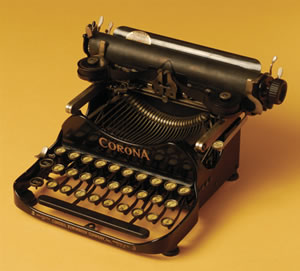The tap-tap-tapping sound of fingers hitting these ivory white keys hasn’t been heard for many years even though a workable ribbon is still wound through the cogs.
Silence, of course, isn’t something typewriters are known for; when in use, this Corona from the First World War era is no exception. But it is a featherweight amongst “writing machines” (as they were occasionally called). Newspaper reporters often took these 10-inch by 11-inch portables – which can be folded inside a purse-sized carrying case – to the frontlines and the high seas to record the horrors of battle. So important were they that “the captain of a battleship insists that there be typewriters on board before he feels fully equipped to meet the enemy,” according to author Bruce Bliven’s book The Wonderful Writing Machine. Today, this Corona sits in the Trinity College archives, a gift from the family of Professor William Selby Rogers (BA 1940). Rogers, who died in 2002, was a French professor at Trinity for more than 30 years and served as the college’s dean of arts from 1974 to 1978. This particular writing machine is shrouded in mystery: could such an unassuming instrument, with its delicate keys and tiny metallic limbs, really have been used to type the names and tragic stories of those who didn’t come home?
Recent Posts
U of T’s Feminist Sports Club Is Here to Bend the Rules
The group invites non-athletes to try their hand at games like dodgeball and basketball in a fun – and distinctly supportive – atmosphere
From Mental Health Studies to Michelin Guide
U of T Scarborough alum Ambica Jain’s unexpected path to restaurant success
A Blueprint for Global Prosperity
Researchers across U of T are banding together to help the United Nations meet its 17 sustainable development goals





